
cifar10-airbench
94% on CIFAR-10 in 2.67 seconds 💨 96% in 27 seconds
Stars: 147
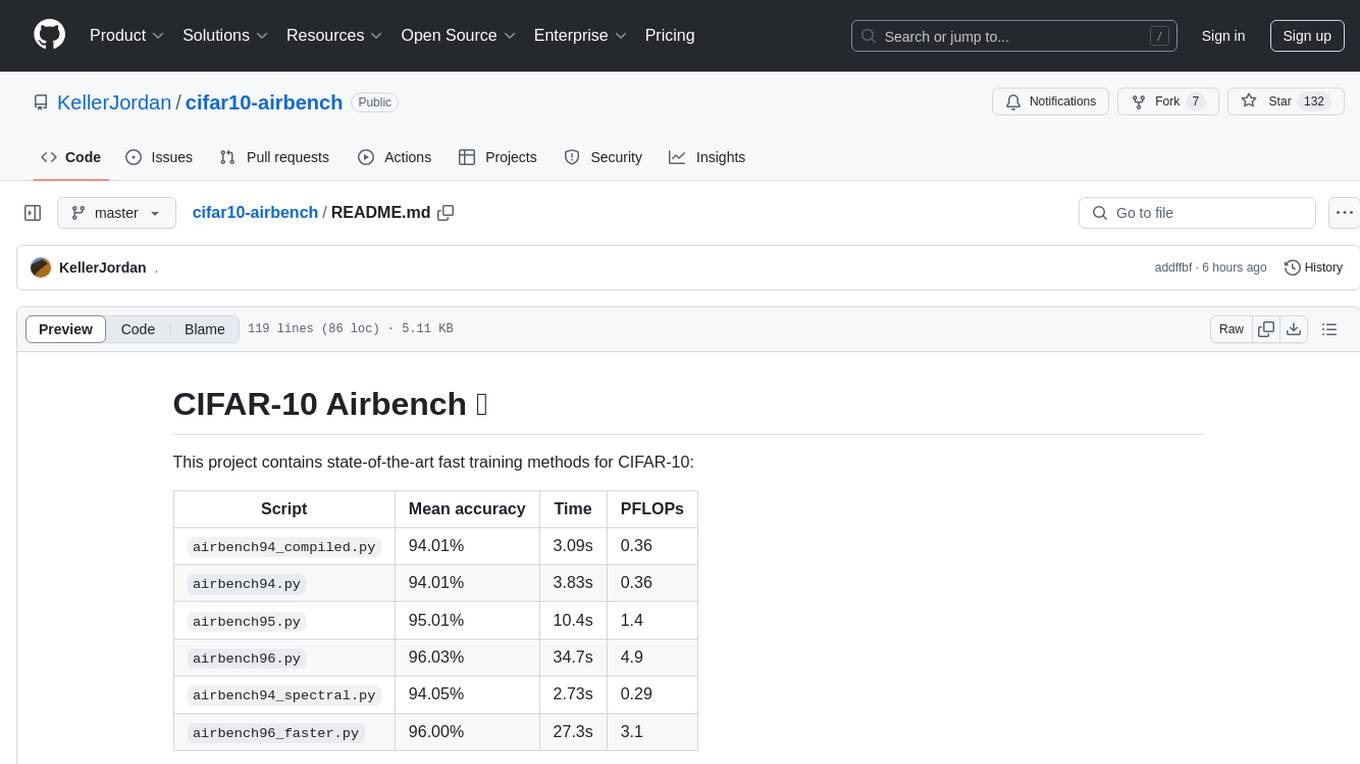
CIFAR-10 Airbench is a project offering fast and stable training baselines for CIFAR-10 dataset, facilitating machine learning research. It provides easily runnable PyTorch scripts for training neural networks with high accuracy levels. The methods used in this project aim to accelerate research on fundamental properties of deep learning. The project includes GPU-accelerated dataloader for custom experiments and trainings, and can be used for data selection and active learning experiments. The training methods provided are faster than standard ResNet training, offering improved performance for research projects.
README:
A collection of fast and self-contained training scripts for CIFAR-10.
| Script | Mean accuracy | Time | PFLOPs |
|---|---|---|---|
airbench94_compiled.py |
94.01% | 3.09s | 0.36 |
airbench94.py |
94.01% | 3.83s | 0.36 |
airbench95.py |
95.01% | 10.4s | 1.4 |
airbench96.py |
96.03% | 34.7s | 4.9 |
airbench94_muon.py |
94.05% | 2.67s | 0.29 |
airbench96_faster.py |
96.00% | 27.3s | 3.1 |
For a comparison, the standard training used in most studies on CIFAR-10 is much slower:
| Baseline | Mean accuracy | Time | PFLOPs |
|---|---|---|---|
| Standard ResNet-18 training | 96% | 7min | 32.3 |
All timings are on a single NVIDIA A100 GPU.
Note: airbench96 has been improved since the paper from 46s to 35s. In addition, airbench96_faster is an improved (but more complicated) method which uses data filtering by a small proxy model.
And airbench94_muon is an improved method using a variant of the Muon optimizer.
The set of methods used to obtain these training speeds are described in the paper.
To train a neural network with 94% accuracy, run either
git clone https://github.com/KellerJordan/cifar10-airbench.git
cd airbench && python airbench94.py
or
pip install airbench
python -c "import airbench; airbench.warmup94(); airbench.train94()"
Note: airbench94_compiled.py and airbench94.py are equivalent (i.e., yield the same distribution of trained networks), and differ only in that the first uses torch.compile to improve GPU utilization. The former is intended for experiments where many networks are trained at once in order to amortize the one-time compilation cost.
CIFAR-10 is one of the most widely used datasets in machine learning, facilitating thousands of research projects per year. This repo provides fast and stable training baselines for CIFAR-10 in order to help accelerate this research. The trainings are provided as easily runnable dependency-free PyTorch scripts, and can replace classic baselines like training ResNet-20 or ResNet-18.
For writing custom CIFAR-10 experiments or trainings, you may find it useful to use the GPU-accelerated dataloader independently.
import airbench
train_loader = airbench.CifarLoader('/tmp/cifar10', train=True, aug=dict(flip=True, translate=4, cutout=16), batch_size=500)
test_loader = airbench.CifarLoader('/tmp/cifar10', train=False, batch_size=1000)
for epoch in range(200):
for inputs, labels in train_loader:
# outputs = model(inputs)
# loss = F.cross_entropy(outputs, labels)
...
If you wish to modify the data in the loader, it can be done like so:
import airbench
train_loader = airbench.CifarLoader('/tmp/cifar10', train=True, aug=dict(flip=True, translate=4, cutout=16), batch_size=500)
mask = (train_loader.labels < 6) # (this is just an example, the mask can be anything)
train_loader.images = train_loader.images[mask]
train_loader.labels = train_loader.labels[mask]
print(len(train_loader)) # The loader now contains 30,000 images and has batch size 500, so this prints 60.
Airbench can be used as a platform for experiments in data selection and active learning. The following is an example experiment which demonstrates the classic result that low-confidence examples provide more training signal than random examples. It runs in <20 seconds on an A100.
import torch
from airbench import train94, infer, evaluate, CifarLoader
net = train94(label_smoothing=0) # train this network without label smoothing to get a better confidence signal
loader = CifarLoader('cifar10', train=True, batch_size=1000)
logits = infer(net, loader)
conf = logits.log_softmax(1).amax(1) # confidence
train_loader = CifarLoader('cifar10', train=True, batch_size=1024, aug=dict(flip=True, translate=2))
mask = (torch.rand(len(train_loader.labels)) < 0.6)
print('Training on %d images selected randomly' % mask.sum())
train_loader.images = train_loader.images[mask]
train_loader.labels = train_loader.labels[mask]
train94(train_loader, epochs=16) # yields around 93% accuracy
train_loader = CifarLoader('cifar10', train=True, batch_size=1024, aug=dict(flip=True, translate=2))
mask = (conf < conf.float().quantile(0.6))
print('Training on %d images selected based on minimum confidence' % mask.sum())
train_loader.images = train_loader.images[mask]
train_loader.labels = train_loader.labels[mask]
train94(train_loader, epochs=16) # yields around 94% accuracy => low-confidence sampling is better than random.
This project builds on the excellent previous record https://github.com/tysam-code/hlb-CIFAR10 (6.3 A100-seconds to 94%).
Which itself builds on the amazing series https://myrtle.ai/learn/how-to-train-your-resnet/ (26 V100-seconds to 94%, which is >=8 A100-seconds)
For Tasks:
Click tags to check more tools for each tasksFor Jobs:
Alternative AI tools for cifar10-airbench
Similar Open Source Tools

cifar10-airbench
CIFAR-10 Airbench is a project offering fast and stable training baselines for CIFAR-10 dataset, facilitating machine learning research. It provides easily runnable PyTorch scripts for training neural networks with high accuracy levels. The methods used in this project aim to accelerate research on fundamental properties of deep learning. The project includes GPU-accelerated dataloader for custom experiments and trainings, and can be used for data selection and active learning experiments. The training methods provided are faster than standard ResNet training, offering improved performance for research projects.
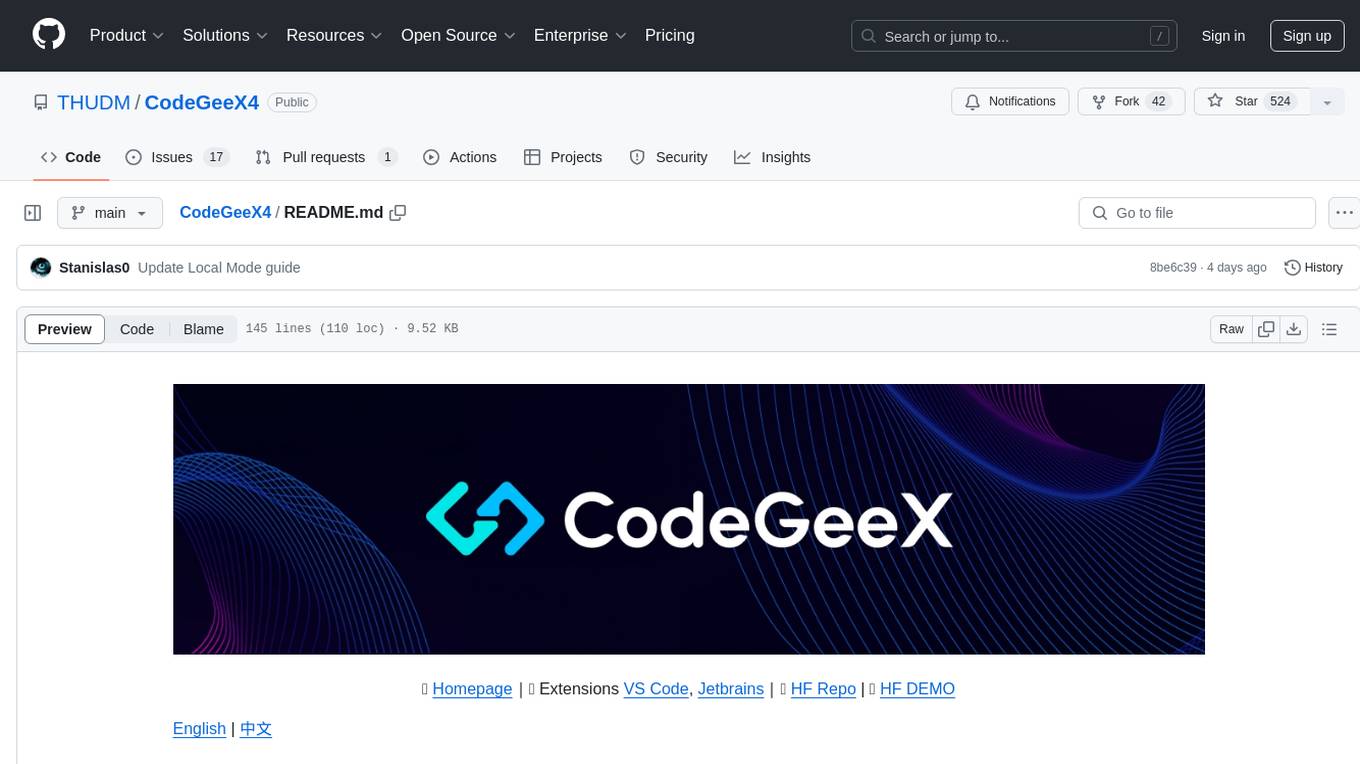
CodeGeeX4
CodeGeeX4-ALL-9B is an open-source multilingual code generation model based on GLM-4-9B, offering enhanced code generation capabilities. It supports functions like code completion, code interpreter, web search, function call, and repository-level code Q&A. The model has competitive performance on benchmarks like BigCodeBench and NaturalCodeBench, outperforming larger models in terms of speed and performance.
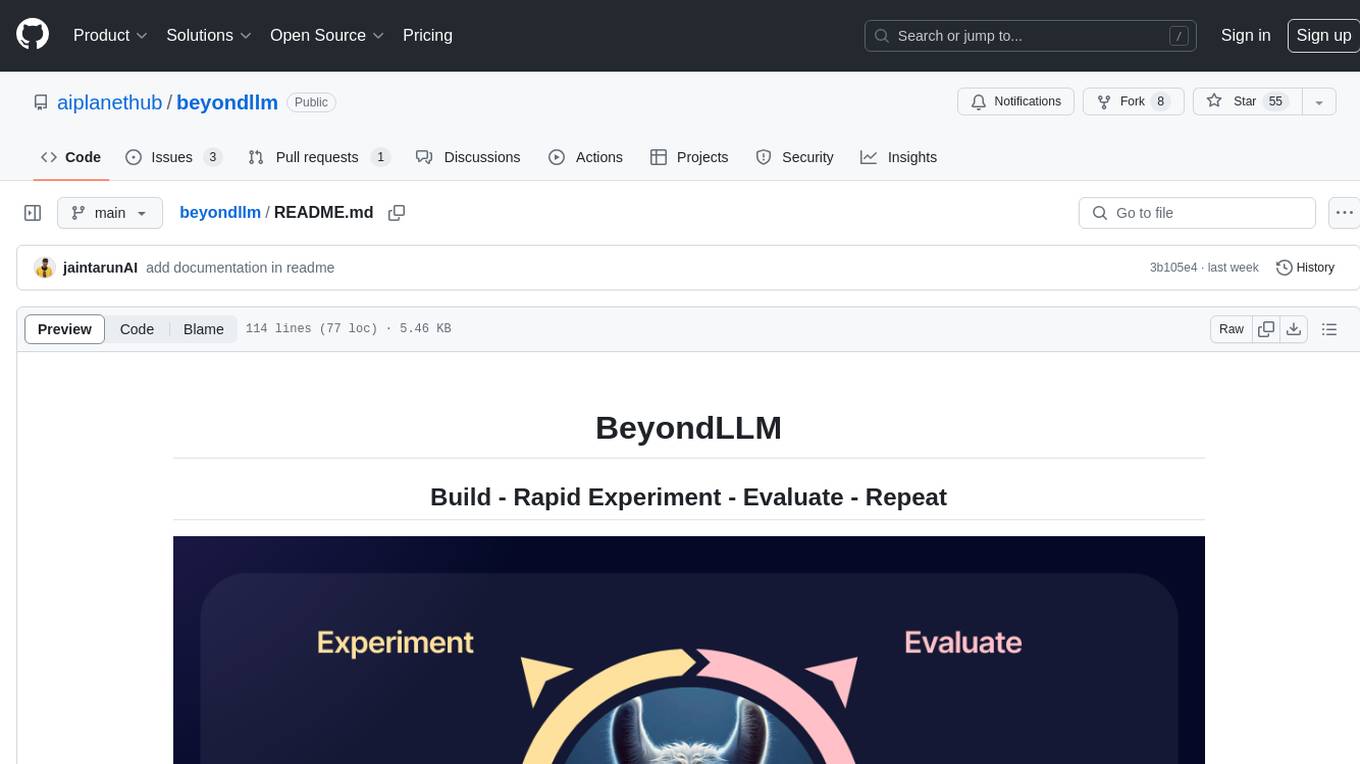
beyondllm
Beyond LLM offers an all-in-one toolkit for experimentation, evaluation, and deployment of Retrieval-Augmented Generation (RAG) systems. It simplifies the process with automated integration, customizable evaluation metrics, and support for various Large Language Models (LLMs) tailored to specific needs. The aim is to reduce LLM hallucination risks and enhance reliability.
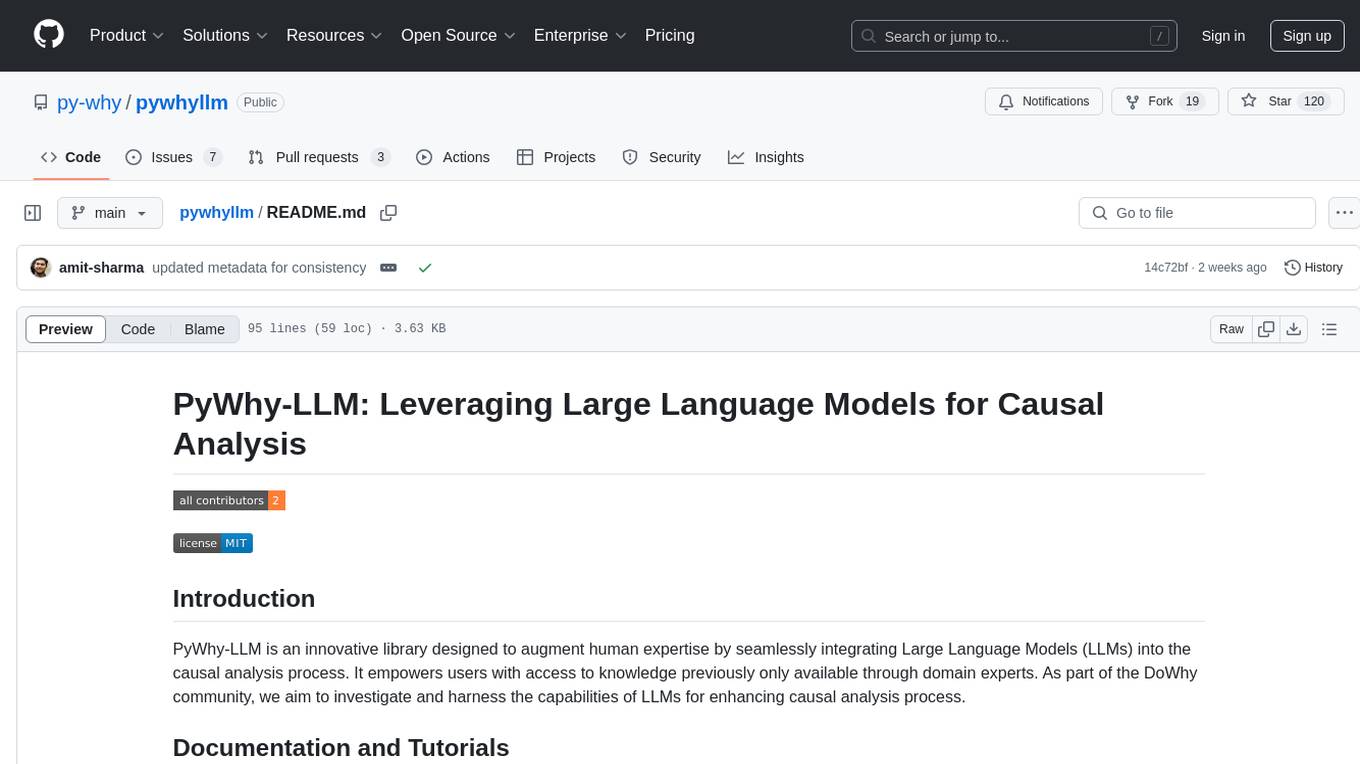
pywhyllm
PyWhy-LLM is an innovative library that integrates Large Language Models (LLMs) into the causal analysis process, empowering users with knowledge previously only available through domain experts. It seamlessly augments causal inference by suggesting potential confounders, relationships between variables, backdoor/frontdoor/iv sets, estimands, critiques of DAGs, latent confounders, and negative controls. The tool aims to enhance the causal analysis process by leveraging the capabilities of LLMs.
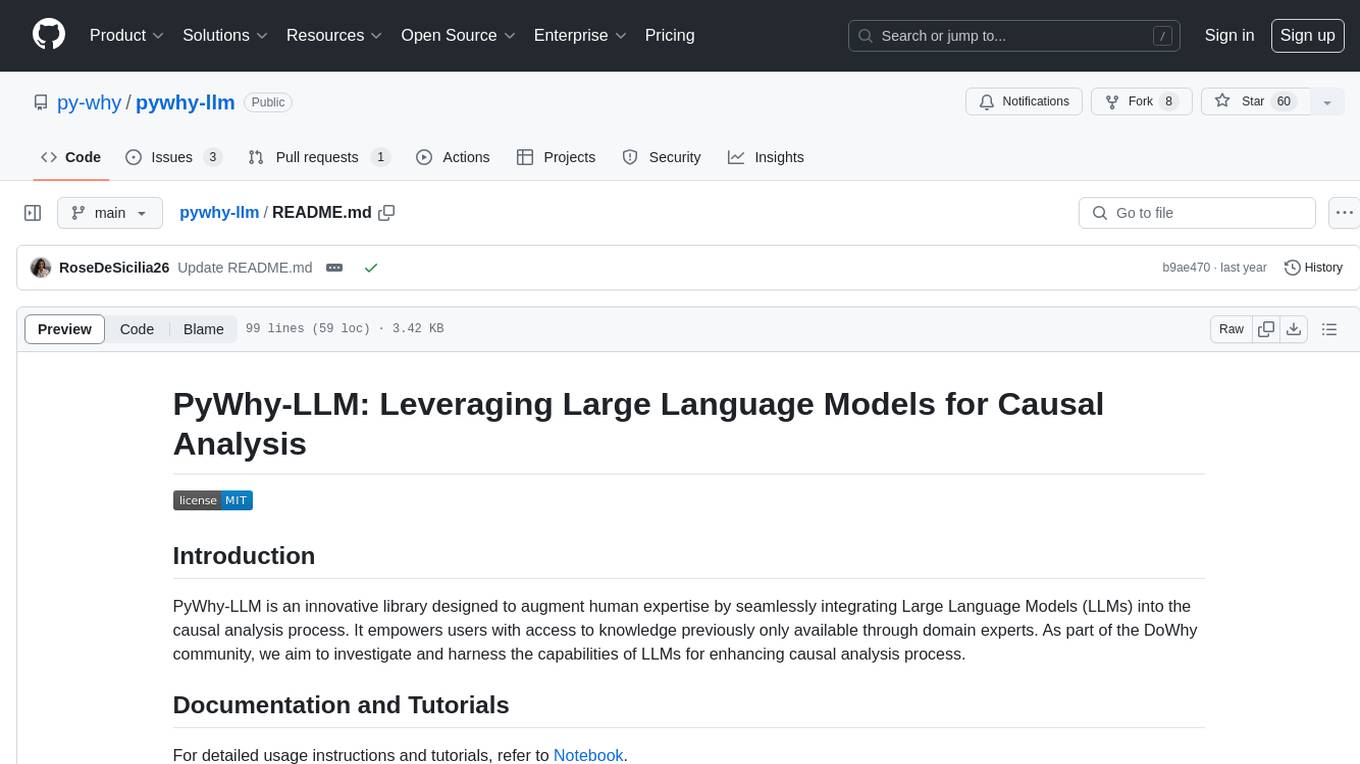
pywhy-llm
PyWhy-LLM is an innovative library that integrates Large Language Models (LLMs) into the causal analysis process, empowering users with knowledge previously only available through domain experts. It seamlessly augments existing causal inference processes by suggesting potential confounders, relationships between variables, backdoor sets, front door sets, IV sets, estimands, critiques of DAGs, latent confounders, and negative controls. By leveraging LLMs and formalizing human-LLM collaboration, PyWhy-LLM aims to enhance causal analysis accessibility and insight.
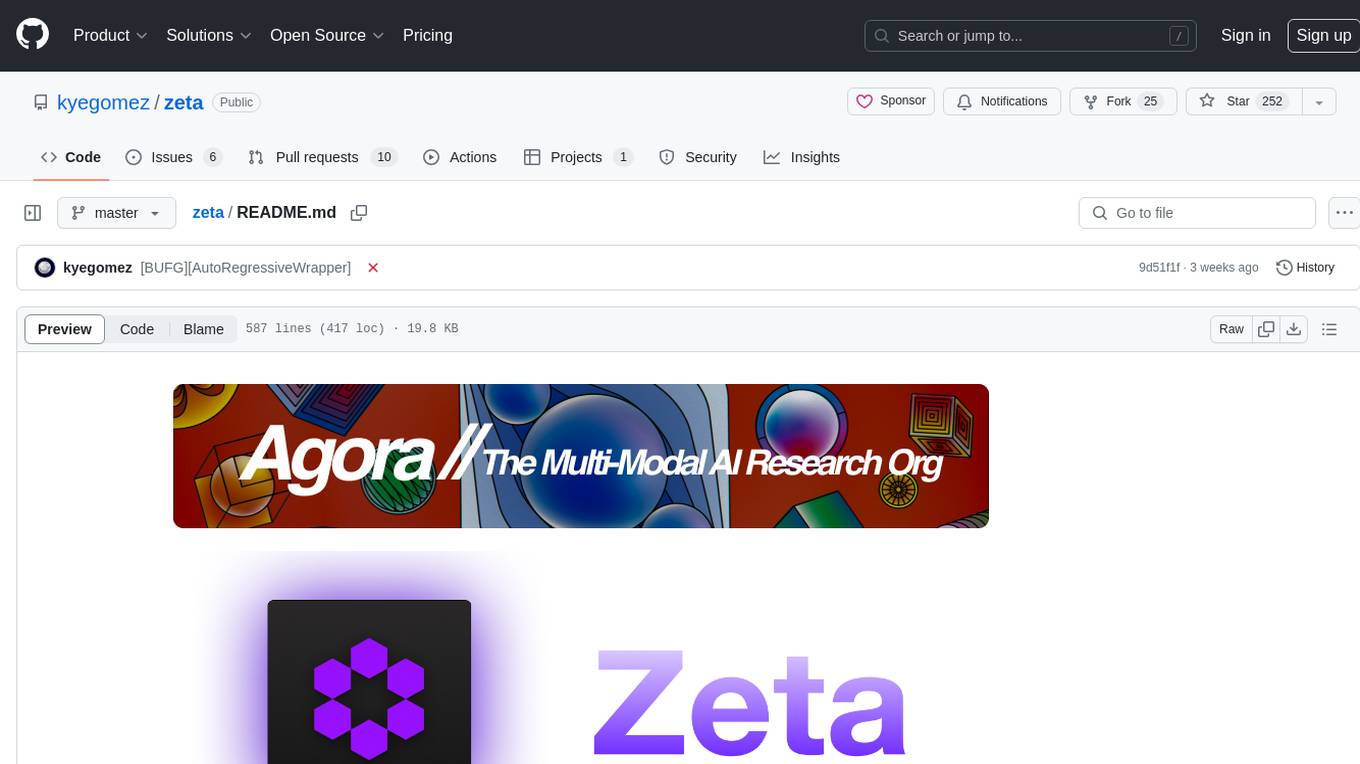
zeta
Zeta is a tool designed to build state-of-the-art AI models faster by providing modular, high-performance, and scalable building blocks. It addresses the common issues faced while working with neural nets, such as chaotic codebases, lack of modularity, and low performance modules. Zeta emphasizes usability, modularity, and performance, and is currently used in hundreds of models across various GitHub repositories. It enables users to prototype, train, optimize, and deploy the latest SOTA neural nets into production. The tool offers various modules like FlashAttention, SwiGLUStacked, RelativePositionBias, FeedForward, BitLinear, PalmE, Unet, VisionEmbeddings, niva, FusedDenseGELUDense, FusedDropoutLayerNorm, MambaBlock, Film, hyper_optimize, DPO, and ZetaCloud for different tasks in AI model development.
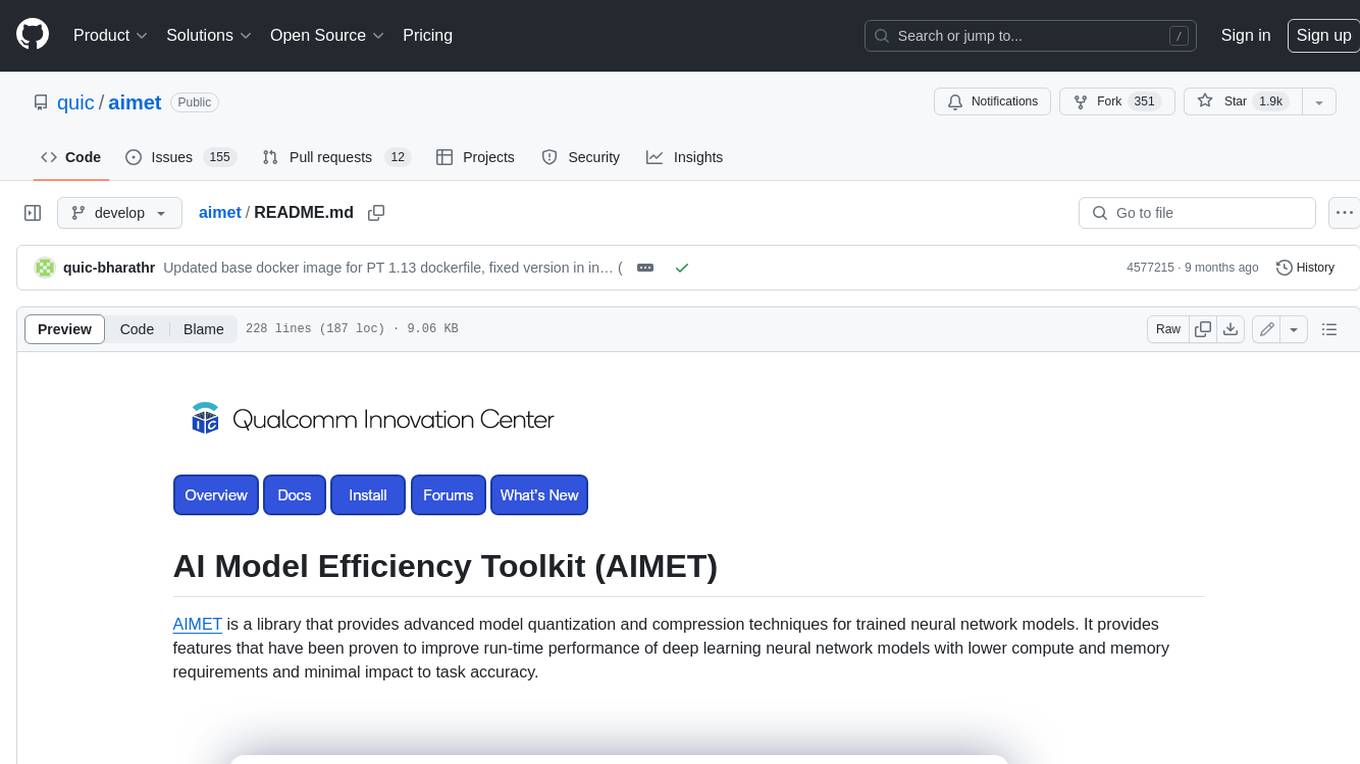
aimet
AIMET is a library that provides advanced model quantization and compression techniques for trained neural network models. It provides features that have been proven to improve run-time performance of deep learning neural network models with lower compute and memory requirements and minimal impact to task accuracy. AIMET is designed to work with PyTorch, TensorFlow and ONNX models. We also host the AIMET Model Zoo - a collection of popular neural network models optimized for 8-bit inference. We also provide recipes for users to quantize floating point models using AIMET.
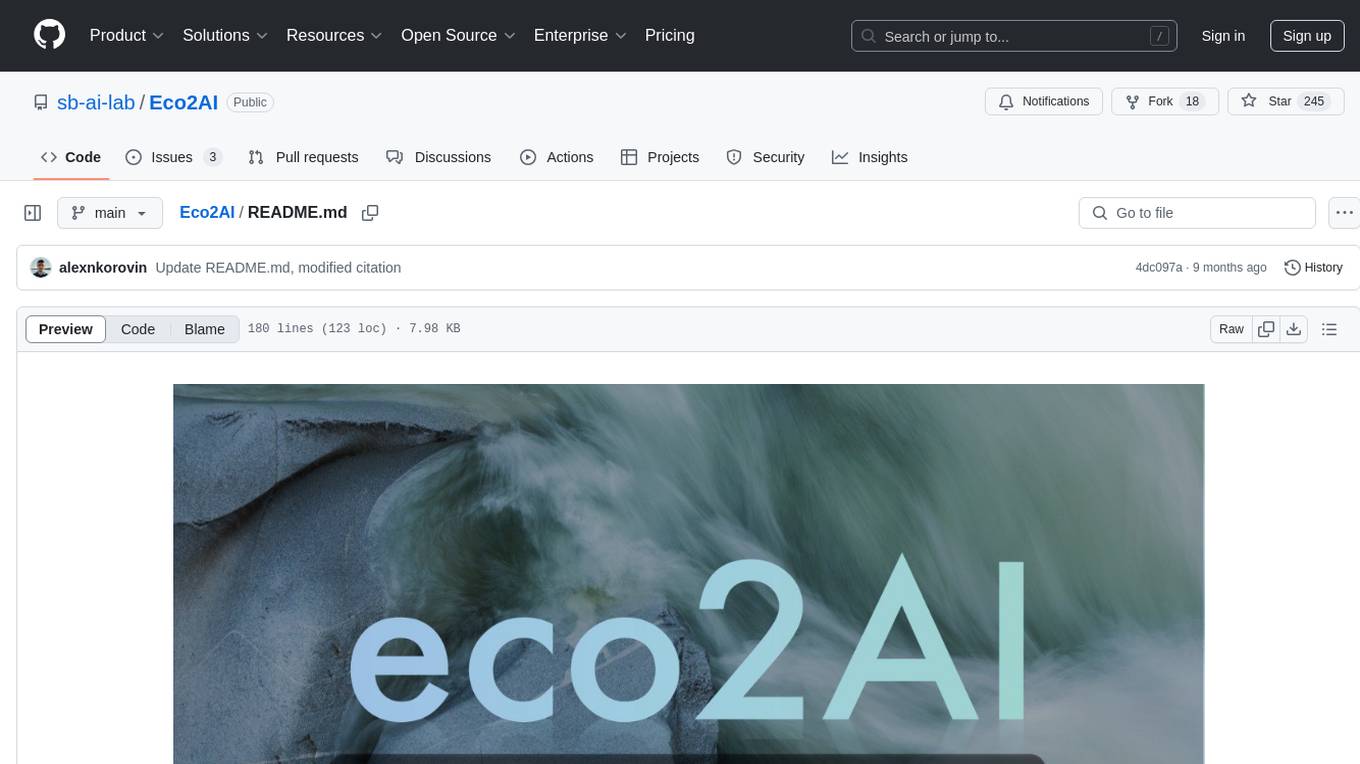
Eco2AI
Eco2AI is a python library for CO2 emission tracking that monitors energy consumption of CPU & GPU devices and estimates equivalent carbon emissions based on regional emission coefficients. Users can easily integrate Eco2AI into their Python scripts by adding a few lines of code. The library records emissions data and device information in a local file, providing detailed session logs with project names, experiment descriptions, start times, durations, power consumption, CO2 emissions, CPU and GPU names, operating systems, and countries.
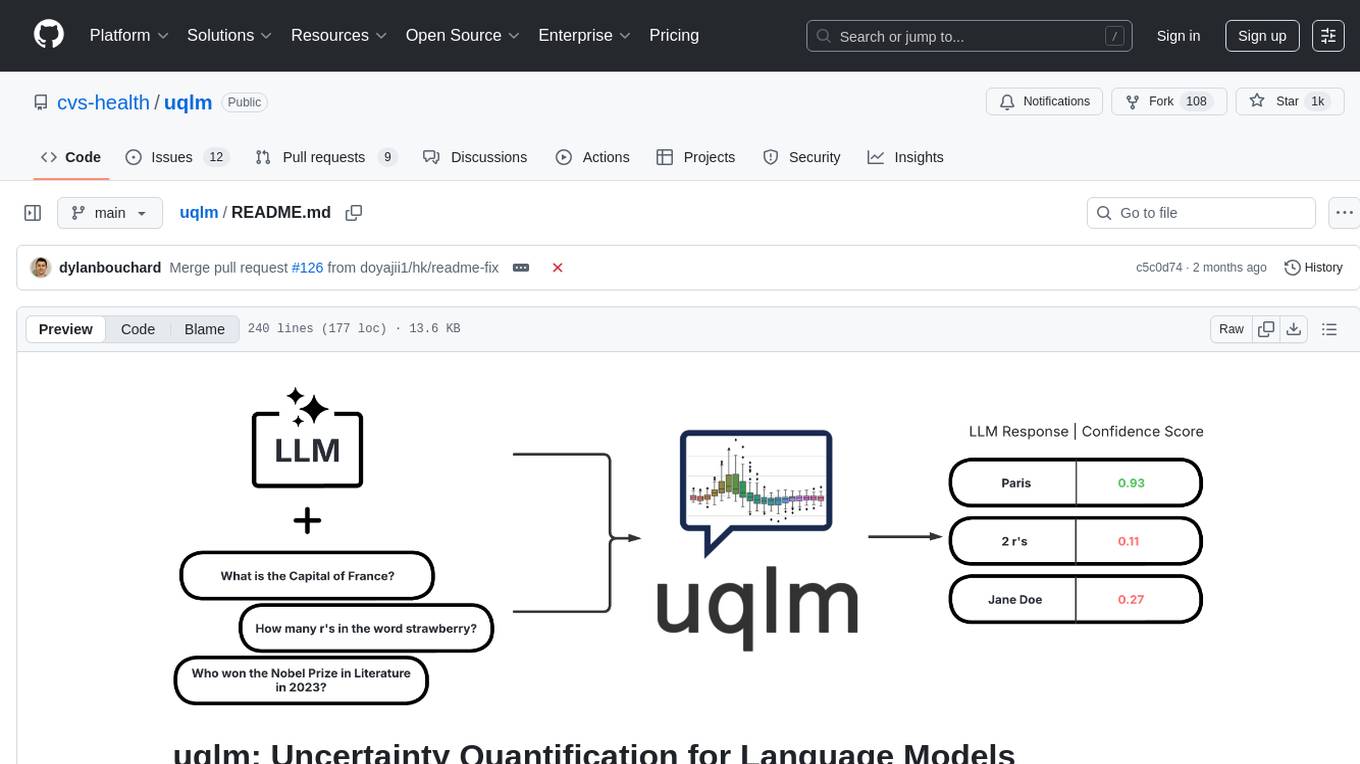
uqlm
UQLM is a Python library for Large Language Model (LLM) hallucination detection using state-of-the-art uncertainty quantification techniques. It provides response-level scorers for quantifying uncertainty of LLM outputs, categorized into four main types: Black-Box Scorers, White-Box Scorers, LLM-as-a-Judge Scorers, and Ensemble Scorers. Users can leverage different scorers to assess uncertainty in generated responses, with options for off-the-shelf usage or customization. The library offers illustrative code snippets and detailed information on available scorers for each type, along with example usage for conducting hallucination detection. Additionally, UQLM includes documentation, example notebooks, and associated research for further exploration and understanding.
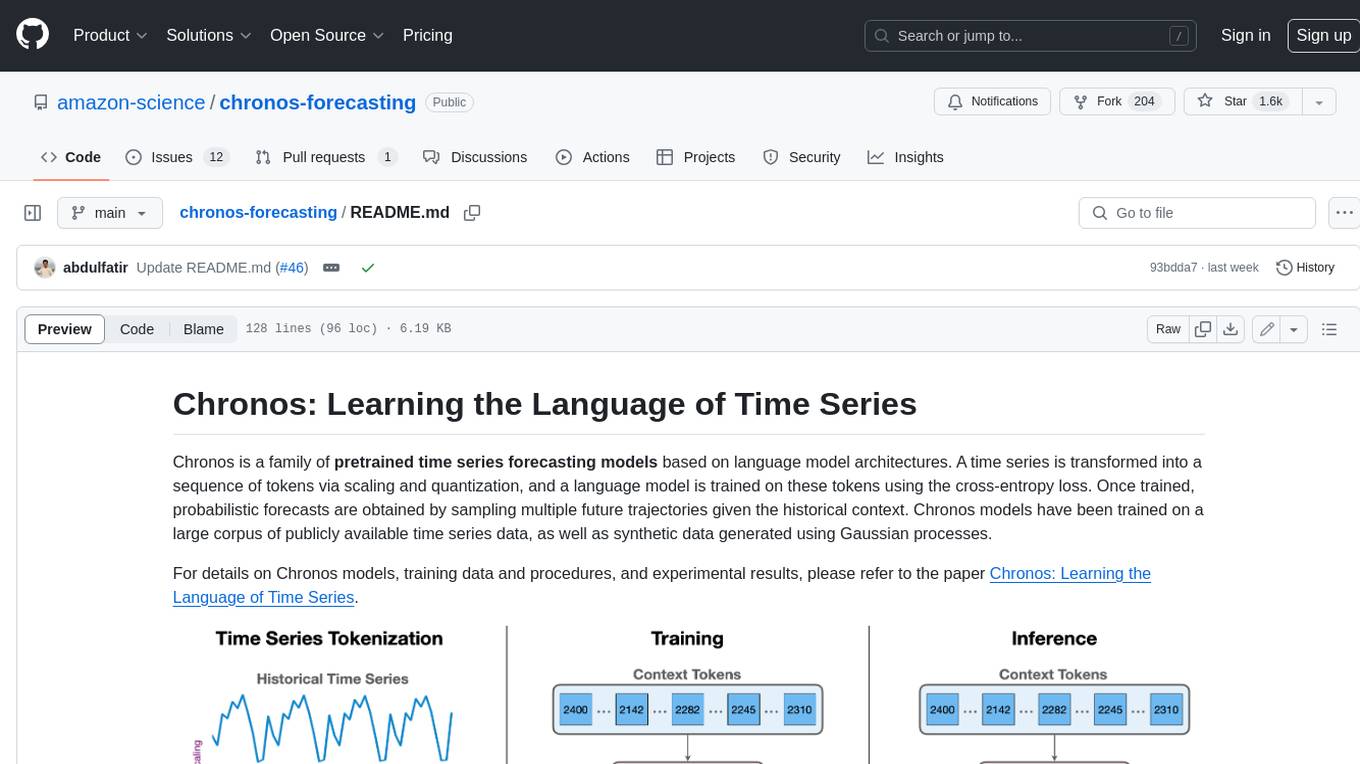
chronos-forecasting
Chronos is a family of pretrained time series forecasting models based on language model architectures. A time series is transformed into a sequence of tokens via scaling and quantization, and a language model is trained on these tokens using the cross-entropy loss. Once trained, probabilistic forecasts are obtained by sampling multiple future trajectories given the historical context. Chronos models have been trained on a large corpus of publicly available time series data, as well as synthetic data generated using Gaussian processes.
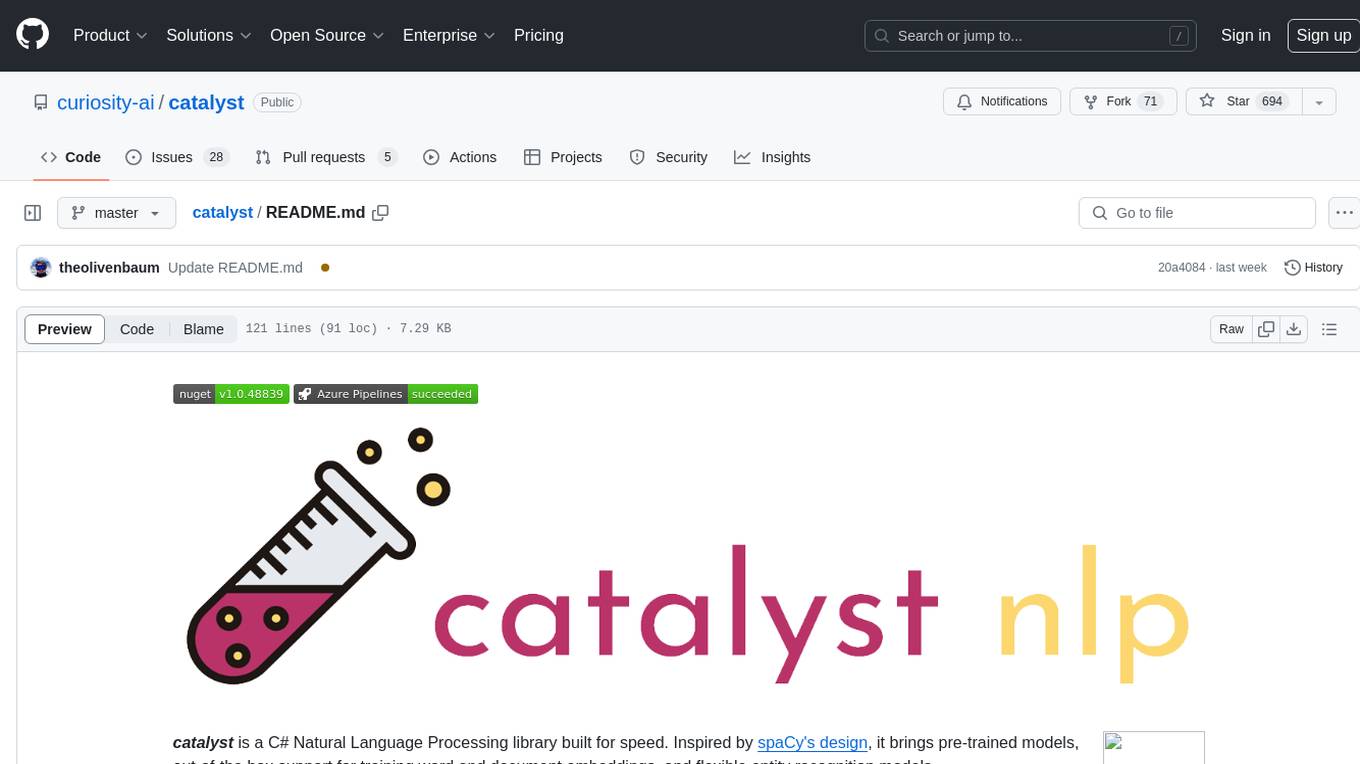
catalyst
Catalyst is a C# Natural Language Processing library designed for speed, inspired by spaCy's design. It provides pre-trained models, support for training word and document embeddings, and flexible entity recognition models. The library is fast, modern, and pure-C#, supporting .NET standard 2.0. It is cross-platform, running on Windows, Linux, macOS, and ARM. Catalyst offers non-destructive tokenization, named entity recognition, part-of-speech tagging, language detection, and efficient binary serialization. It includes pre-built models for language packages and lemmatization. Users can store and load models using streams. Getting started with Catalyst involves installing its NuGet Package and setting the storage to use the online repository. The library supports lazy loading of models from disk or online. Users can take advantage of C# lazy evaluation and native multi-threading support to process documents in parallel. Training a new FastText word2vec embedding model is straightforward, and Catalyst also provides algorithms for fast embedding search and dimensionality reduction.
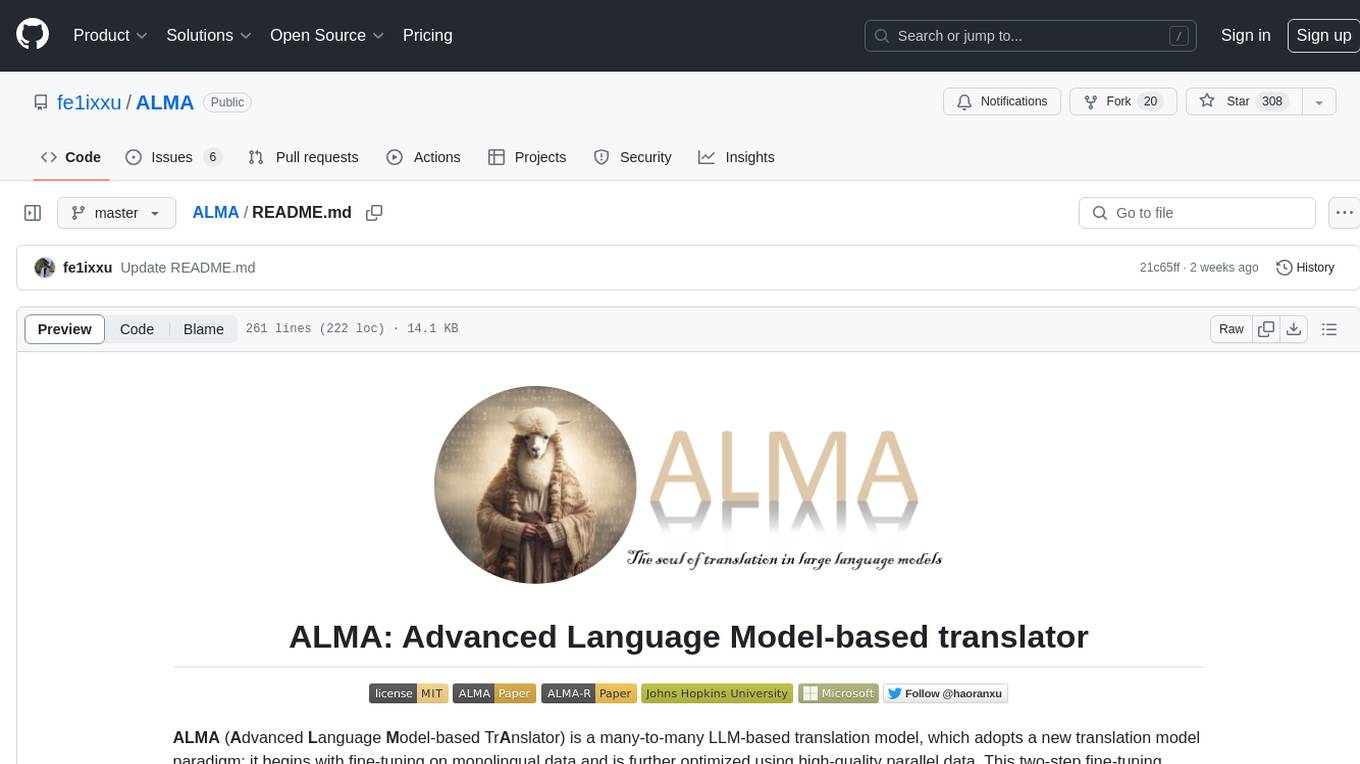
ALMA
ALMA (Advanced Language Model-based Translator) is a many-to-many LLM-based translation model that utilizes a two-step fine-tuning process on monolingual and parallel data to achieve strong translation performance. ALMA-R builds upon ALMA models with LoRA fine-tuning and Contrastive Preference Optimization (CPO) for even better performance, surpassing GPT-4 and WMT winners. The repository provides ALMA and ALMA-R models, datasets, environment setup, evaluation scripts, training guides, and data information for users to leverage these models for translation tasks.
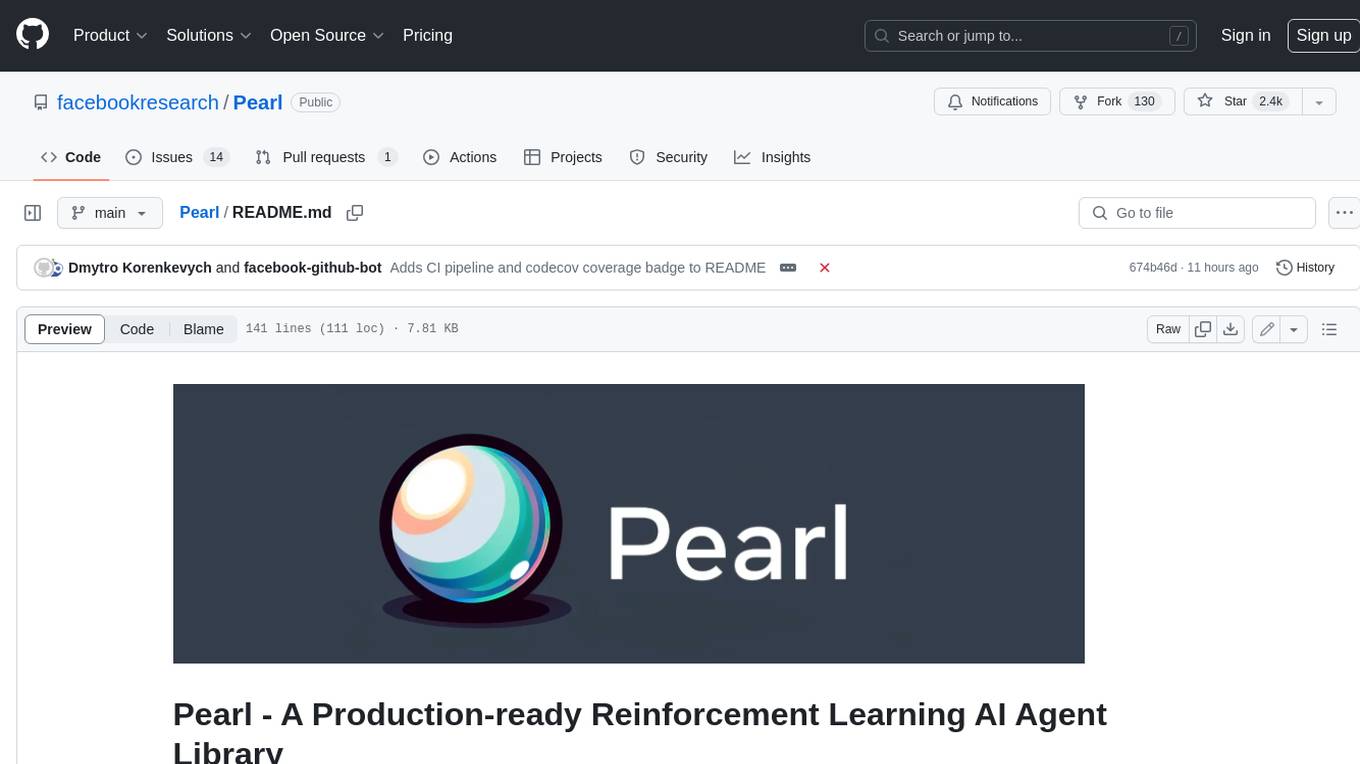
Pearl
Pearl is a production-ready Reinforcement Learning AI agent library open-sourced by the Applied Reinforcement Learning team at Meta. It enables researchers and practitioners to develop Reinforcement Learning AI agents that prioritize cumulative long-term feedback over immediate feedback and can adapt to environments with limited observability, sparse feedback, and high stochasticity. Pearl offers a diverse set of unique features for production environments, including dynamic action spaces, offline learning, intelligent neural exploration, safe decision making, history summarization, and data augmentation.
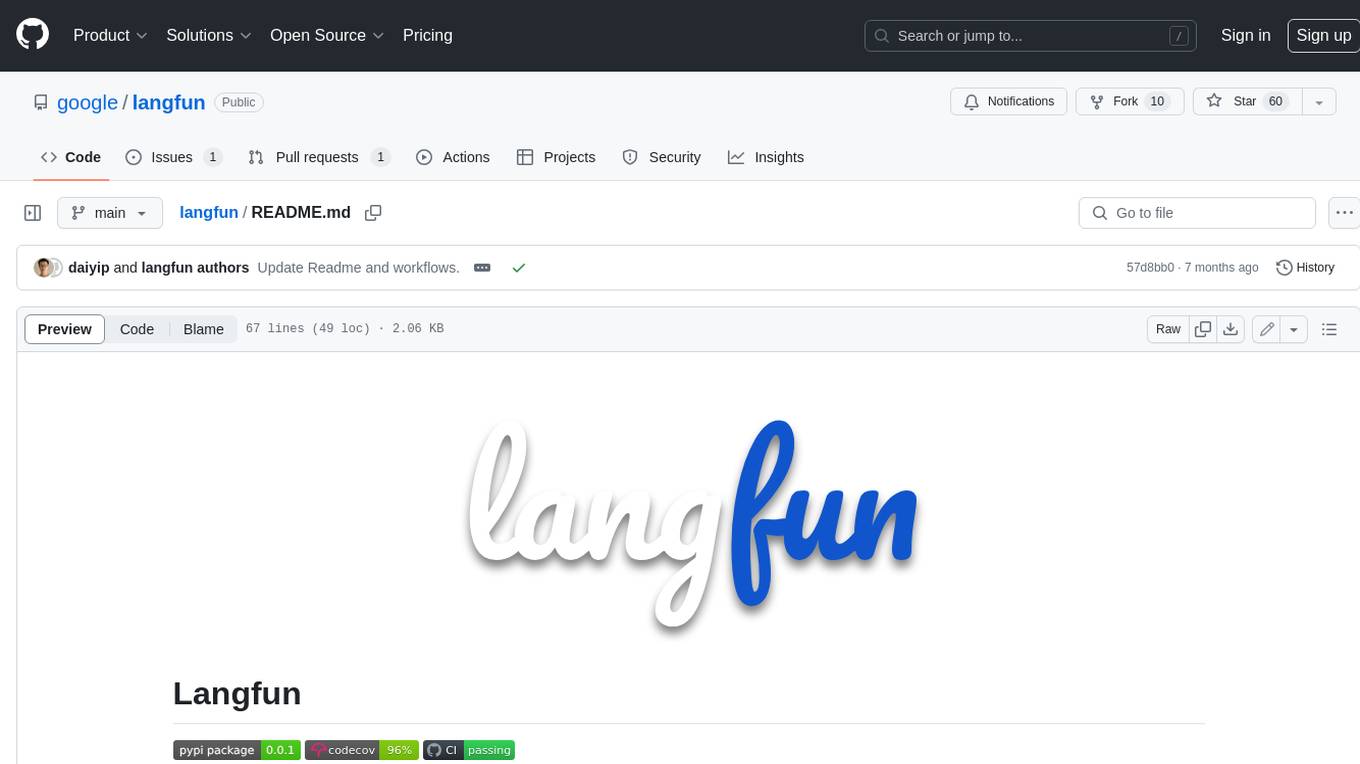
langfun
Langfun is a Python library that aims to make language models (LM) fun to work with. It enables a programming model that flows naturally, resembling the human thought process. Langfun emphasizes the reuse and combination of language pieces to form prompts, thereby accelerating innovation. Unlike other LM frameworks, which feed program-generated data into the LM, langfun takes a distinct approach: It starts with natural language, allowing for seamless interactions between language and program logic, and concludes with natural language and optional structured output. Consequently, langfun can aptly be described as Language as functions, capturing the core of its methodology.

pytorch-forecasting
PyTorch Forecasting is a PyTorch-based package designed for state-of-the-art timeseries forecasting using deep learning architectures. It offers a high-level API and leverages PyTorch Lightning for efficient training on GPU or CPU with automatic logging. The package aims to simplify timeseries forecasting tasks by providing a flexible API for professionals and user-friendly defaults for beginners. It includes features such as a timeseries dataset class for handling data transformations, missing values, and subsampling, various neural network architectures optimized for real-world deployment, multi-horizon timeseries metrics, and hyperparameter tuning with optuna. Built on pytorch-lightning, it supports training on CPUs, single GPUs, and multiple GPUs out-of-the-box.
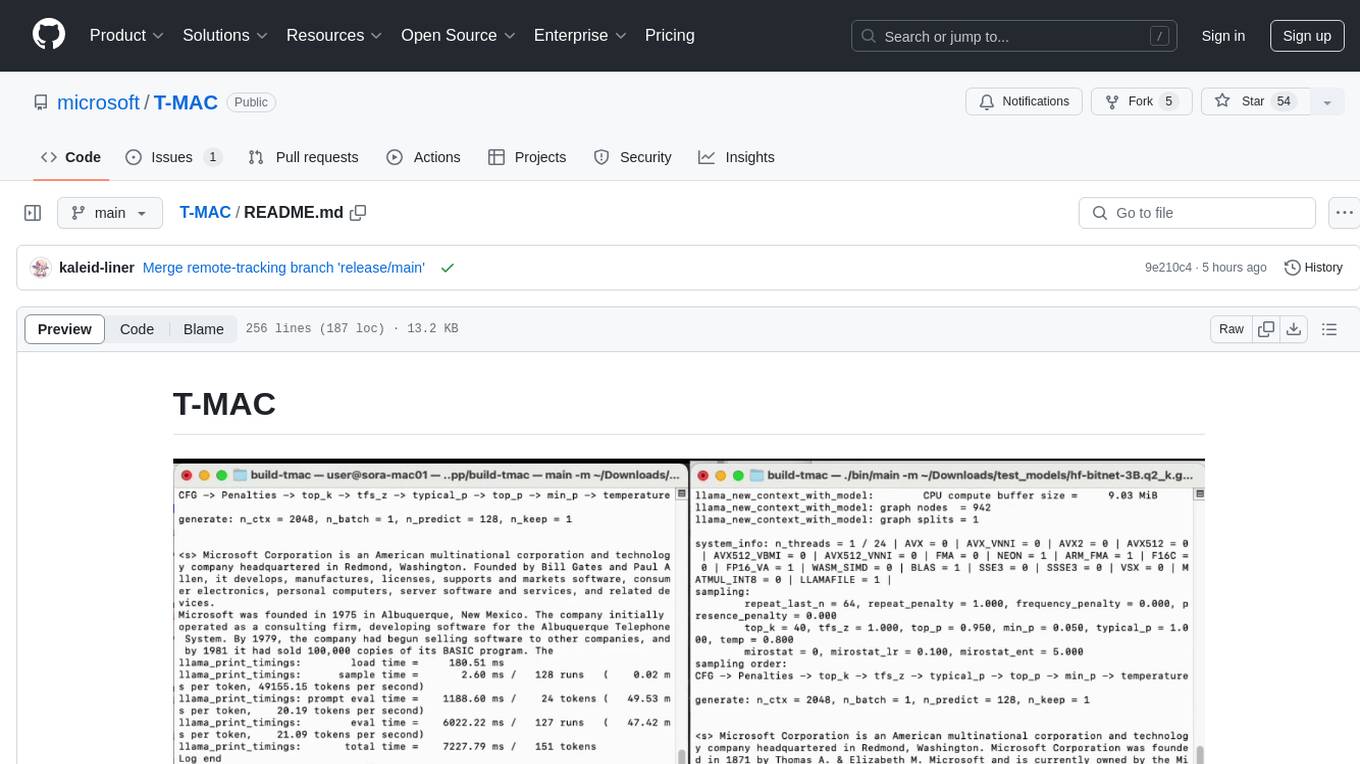
T-MAC
T-MAC is a kernel library that directly supports mixed-precision matrix multiplication without the need for dequantization by utilizing lookup tables. It aims to boost low-bit LLM inference on CPUs by offering support for various low-bit models. T-MAC achieves significant speedup compared to SOTA CPU low-bit framework (llama.cpp) and can even perform well on lower-end devices like Raspberry Pi 5. The tool demonstrates superior performance over existing low-bit GEMM kernels on CPU, reduces power consumption, and provides energy savings. It achieves comparable performance to CUDA GPU on certain tasks while delivering considerable power and energy savings. T-MAC's method involves using lookup tables to support mpGEMM and employs key techniques like precomputing partial sums, shift and accumulate operations, and utilizing tbl/pshuf instructions for fast table lookup.
For similar tasks

cifar10-airbench
CIFAR-10 Airbench is a project offering fast and stable training baselines for CIFAR-10 dataset, facilitating machine learning research. It provides easily runnable PyTorch scripts for training neural networks with high accuracy levels. The methods used in this project aim to accelerate research on fundamental properties of deep learning. The project includes GPU-accelerated dataloader for custom experiments and trainings, and can be used for data selection and active learning experiments. The training methods provided are faster than standard ResNet training, offering improved performance for research projects.
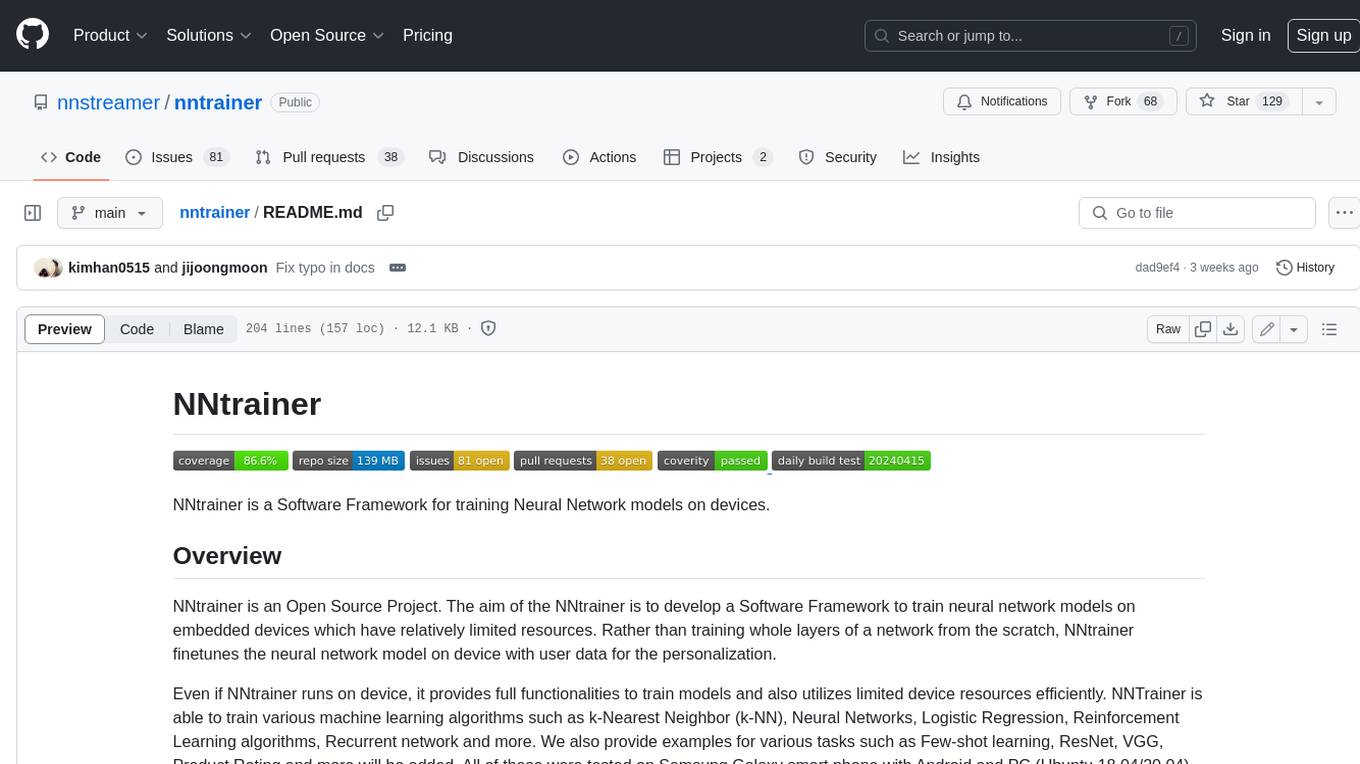
nntrainer
NNtrainer is a software framework for training neural network models on devices with limited resources. It enables on-device fine-tuning of neural networks using user data for personalization. NNtrainer supports various machine learning algorithms and provides examples for tasks such as few-shot learning, ResNet, VGG, and product rating. It is optimized for embedded devices and utilizes CBLAS and CUBLAS for accelerated calculations. NNtrainer is open source and released under the Apache License version 2.0.
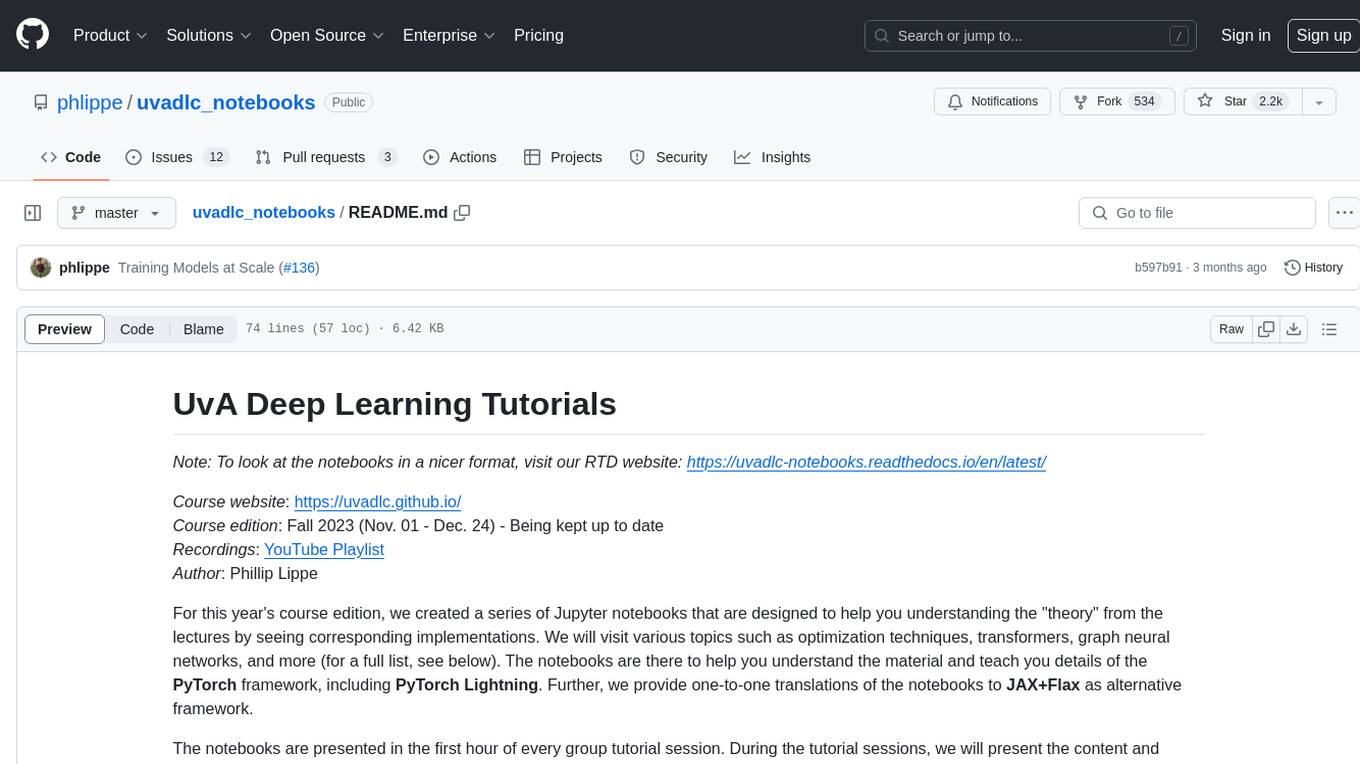
uvadlc_notebooks
The UvA Deep Learning Tutorials repository contains a series of Jupyter notebooks designed to help understand theoretical concepts from lectures by providing corresponding implementations. The notebooks cover topics such as optimization techniques, transformers, graph neural networks, and more. They aim to teach details of the PyTorch framework, including PyTorch Lightning, with alternative translations to JAX+Flax. The tutorials are integrated as official tutorials of PyTorch Lightning and are relevant for graded assignments and exams.
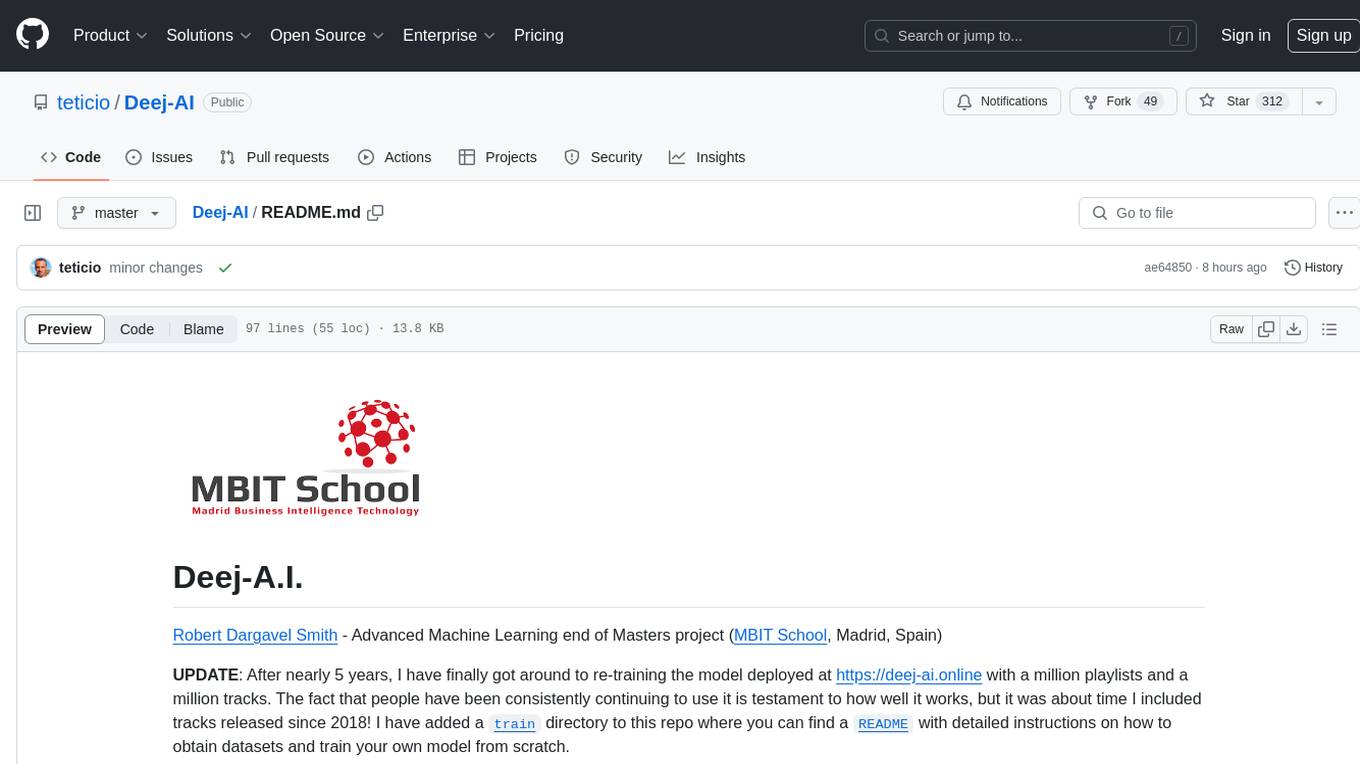
Deej-AI
Deej-A.I. is an advanced machine learning project that aims to revolutionize music recommendation systems by using artificial intelligence to analyze and recommend songs based on their content and characteristics. The project involves scraping playlists from Spotify, creating embeddings of songs, training neural networks to analyze spectrograms, and generating recommendations based on similarities in music features. Deej-A.I. offers a unique approach to music curation, focusing on the 'what' rather than the 'how' of DJing, and providing users with personalized and creative music suggestions.
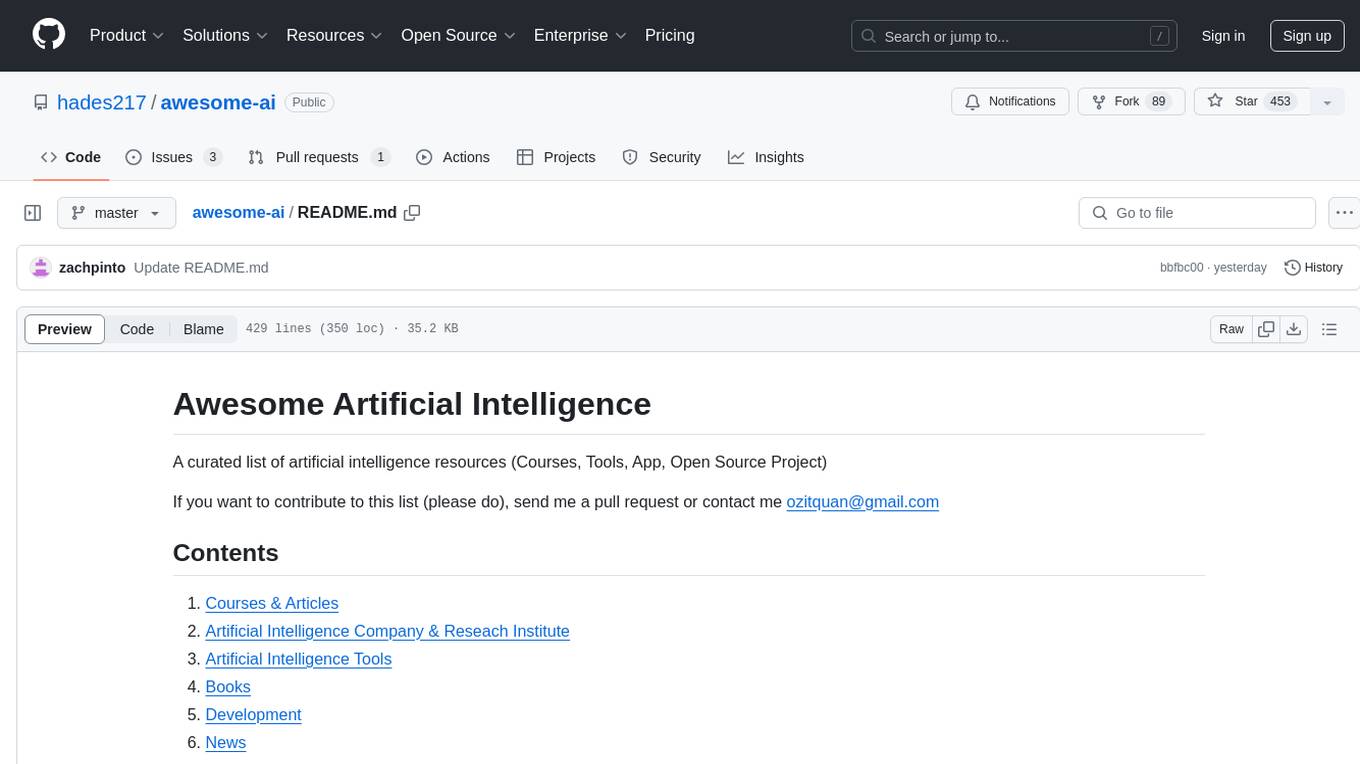
awesome-ai
Awesome AI is a curated list of artificial intelligence resources including courses, tools, apps, and open-source projects. It covers a wide range of topics such as machine learning, deep learning, natural language processing, robotics, conversational interfaces, data science, and more. The repository serves as a comprehensive guide for individuals interested in exploring the field of artificial intelligence and its applications across various domains.
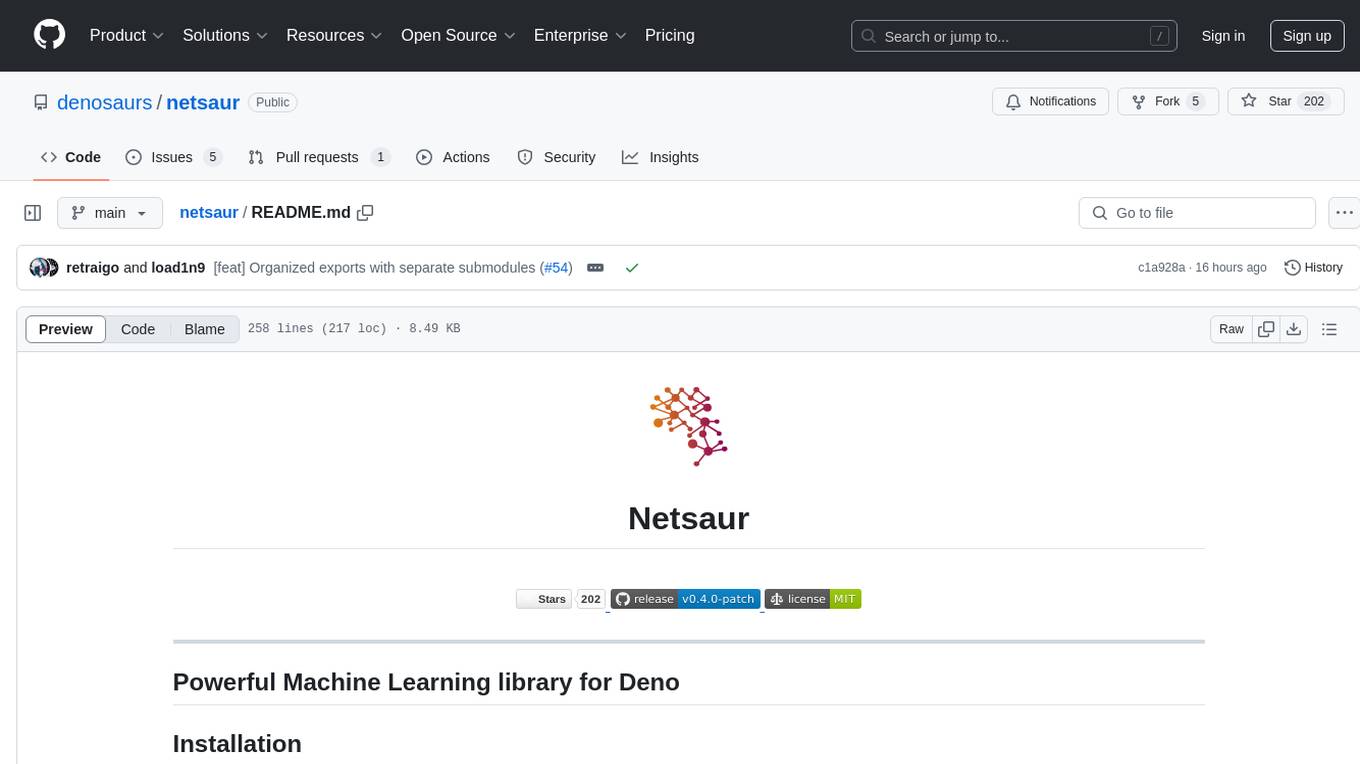
netsaur
Netsaur is a powerful machine learning library for Deno, offering a lightweight and easy-to-use neural network solution. It is blazingly fast and efficient, providing a simple API for creating and training neural networks. Netsaur can run on both CPU and GPU, making it suitable for serverless environments. With Netsaur, users can quickly build and deploy machine learning models for various applications with minimal dependencies. This library is perfect for both beginners and experienced machine learning practitioners.
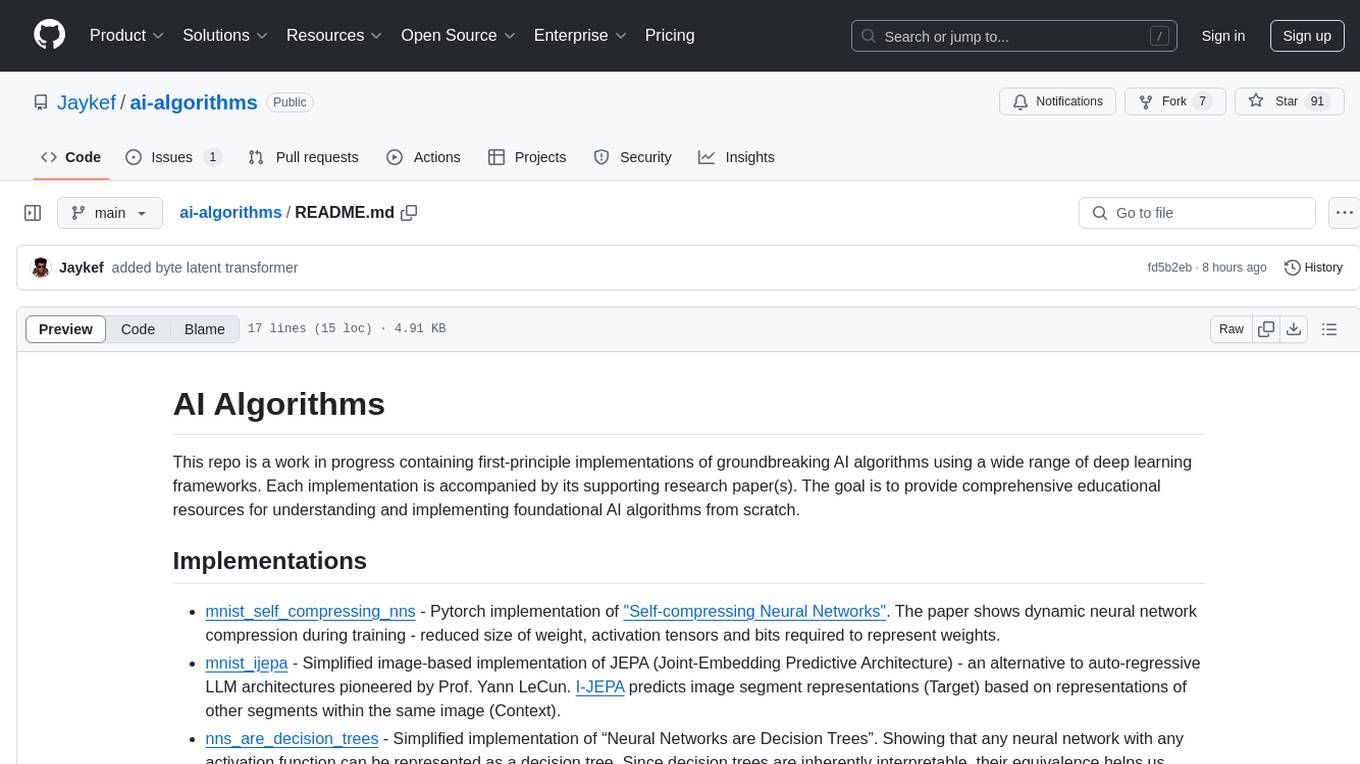
ai-algorithms
This repository is a work in progress that contains first-principle implementations of groundbreaking AI algorithms using various deep learning frameworks. Each implementation is accompanied by supporting research papers, aiming to provide comprehensive educational resources for understanding and implementing foundational AI algorithms from scratch.
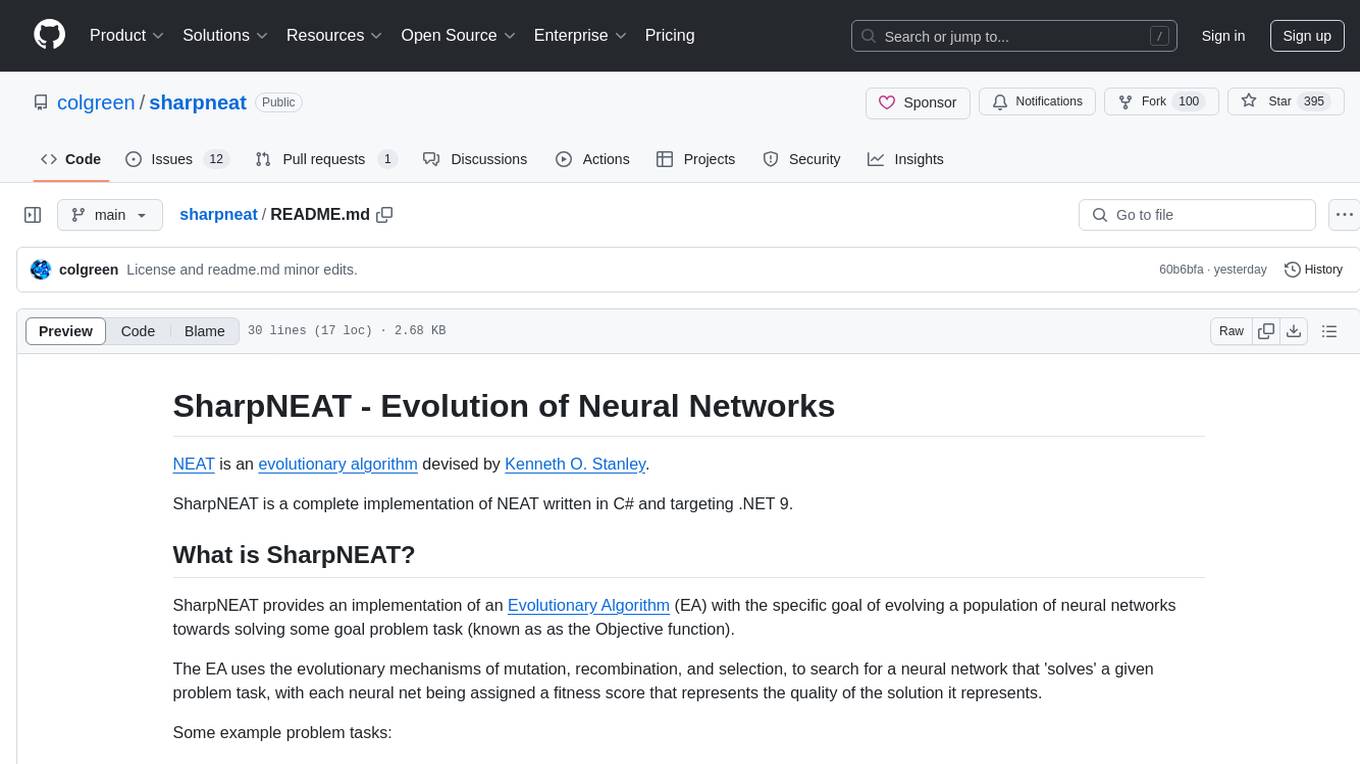
sharpneat
SharpNEAT is a complete implementation of NEAT written in C# and targeting .NET 9. It provides an implementation of an Evolutionary Algorithm (EA) with the specific goal of evolving a population of neural networks towards solving some goal problem task. The framework facilitates research into evolutionary computation and specifically evolution of neural networks, allowing for modular experimentation with genetic coding and evolutionary algorithms.
For similar jobs

sweep
Sweep is an AI junior developer that turns bugs and feature requests into code changes. It automatically handles developer experience improvements like adding type hints and improving test coverage.

teams-ai
The Teams AI Library is a software development kit (SDK) that helps developers create bots that can interact with Teams and Microsoft 365 applications. It is built on top of the Bot Framework SDK and simplifies the process of developing bots that interact with Teams' artificial intelligence capabilities. The SDK is available for JavaScript/TypeScript, .NET, and Python.

ai-guide
This guide is dedicated to Large Language Models (LLMs) that you can run on your home computer. It assumes your PC is a lower-end, non-gaming setup.

classifai
Supercharge WordPress Content Workflows and Engagement with Artificial Intelligence. Tap into leading cloud-based services like OpenAI, Microsoft Azure AI, Google Gemini and IBM Watson to augment your WordPress-powered websites. Publish content faster while improving SEO performance and increasing audience engagement. ClassifAI integrates Artificial Intelligence and Machine Learning technologies to lighten your workload and eliminate tedious tasks, giving you more time to create original content that matters.

chatbot-ui
Chatbot UI is an open-source AI chat app that allows users to create and deploy their own AI chatbots. It is easy to use and can be customized to fit any need. Chatbot UI is perfect for businesses, developers, and anyone who wants to create a chatbot.

BricksLLM
BricksLLM is a cloud native AI gateway written in Go. Currently, it provides native support for OpenAI, Anthropic, Azure OpenAI and vLLM. BricksLLM aims to provide enterprise level infrastructure that can power any LLM production use cases. Here are some use cases for BricksLLM: * Set LLM usage limits for users on different pricing tiers * Track LLM usage on a per user and per organization basis * Block or redact requests containing PIIs * Improve LLM reliability with failovers, retries and caching * Distribute API keys with rate limits and cost limits for internal development/production use cases * Distribute API keys with rate limits and cost limits for students

uAgents
uAgents is a Python library developed by Fetch.ai that allows for the creation of autonomous AI agents. These agents can perform various tasks on a schedule or take action on various events. uAgents are easy to create and manage, and they are connected to a fast-growing network of other uAgents. They are also secure, with cryptographically secured messages and wallets.

griptape
Griptape is a modular Python framework for building AI-powered applications that securely connect to your enterprise data and APIs. It offers developers the ability to maintain control and flexibility at every step. Griptape's core components include Structures (Agents, Pipelines, and Workflows), Tasks, Tools, Memory (Conversation Memory, Task Memory, and Meta Memory), Drivers (Prompt and Embedding Drivers, Vector Store Drivers, Image Generation Drivers, Image Query Drivers, SQL Drivers, Web Scraper Drivers, and Conversation Memory Drivers), Engines (Query Engines, Extraction Engines, Summary Engines, Image Generation Engines, and Image Query Engines), and additional components (Rulesets, Loaders, Artifacts, Chunkers, and Tokenizers). Griptape enables developers to create AI-powered applications with ease and efficiency.

